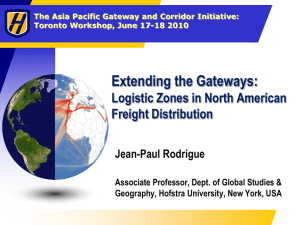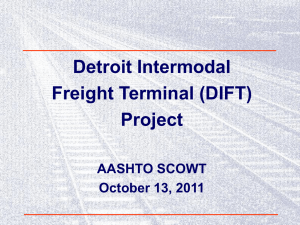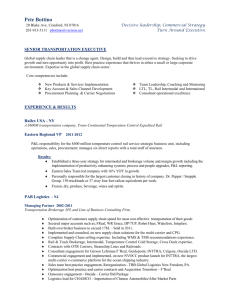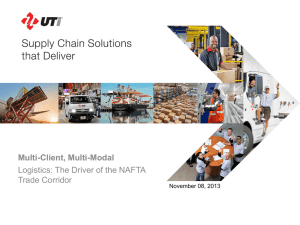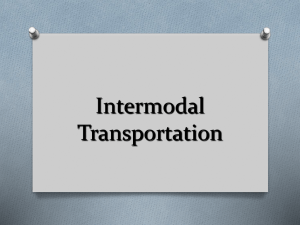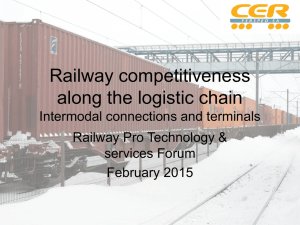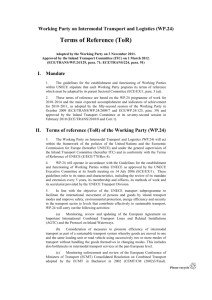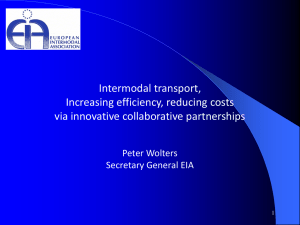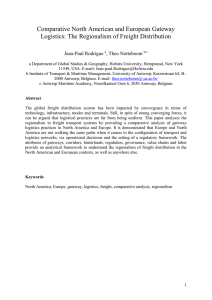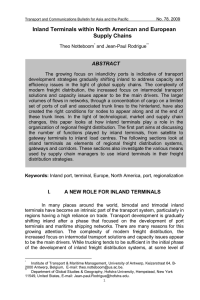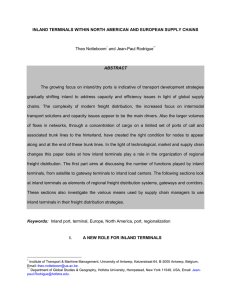Inland Ports and Freight Regionalization in North America
advertisement
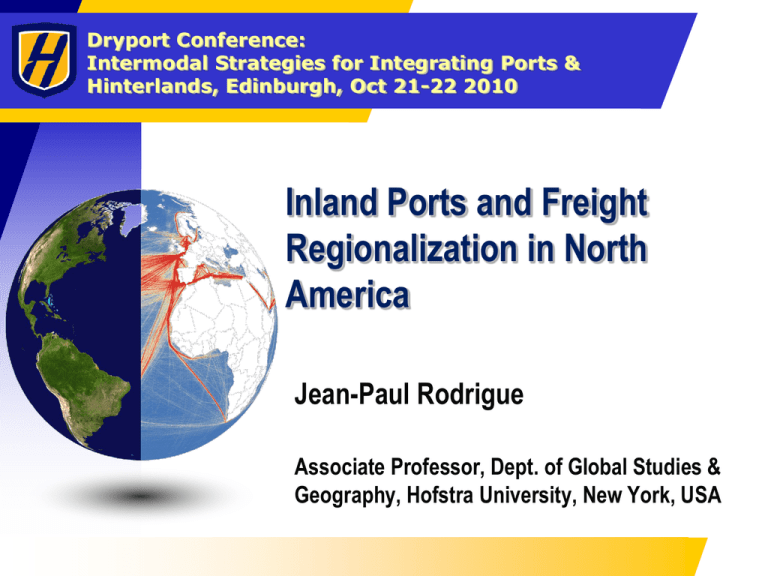
Dryport Conference: Intermodal Strategies for Integrating Ports & Hinterlands, Edinburgh, Oct 21-22 2010 Inland Ports and Freight Regionalization in North America Jean-Paul Rodrigue Associate Professor, Dept. of Global Studies & Geography, Hofstra University, New York, USA What Drives Supply Chain Management? Control Freaks… Offshoring Costs / time / reliability Internalize efficiency North American Intermodal Transportation: Emerging Paradoxes Geographical and functional diffusion of containerization. Massive investments. Rationalisation (corridors and sites). New standards, practices and technologies. Increasing returns. Incremental changes. Decreasing returns. Consolidation (maritime, rail and trucking). Emergence of large operators. PPP. Supply chain control. Addedvalue-capture. The Insertion of Inland Ports in North America: Basic Requirements Rail Corridor to the Gateway Intermodal Rail Terminal Logistics Activities Northwest Ohio Intermodal Terminal, CSX 2011; An Inland “Port” The Complexities of Inland Logistics: The “Last Mile” in Freight Distribution Massification Atomization Frequency Capacity Shipping Network 1 Gateway 1 REGIONAL LOCAL HINTERLAND GLOBAL Inventory in transit Corridor 2 Segment Inland Terminal 2 Distribution Center Customer “Last Mile” Inventory at terminal Functional Relations between Inland Terminals and their Hinterland Freight Region Logistics Pole FLOWS & INTEGRATION Inland Terminal I II Logistics activities Retailing and manufacturing activities III American Foreign Trade by Maritime Containers, 2009 (in TEUs) Importers Whirlpool Nike Red Bull General Electric Jarden JC Penney Samsung Ikea Intl. Ashley Furniture Chiquita Heineken Philips LG Group Costco Wholsale Lowe's Sears Holding Dole Food Home Depot Target Wal-Mart Exporters Cellmark Group Genesis Resource… Meadwestvaco Sims Metal Management Delong Shintech Cedarwood-Young ExxonMobil JC Horizon Dupont Procter & Gamble Denison Intl. Potential Industries Cargill Dow Chemical Newport Ch Intl Weyerhaeuser International Paper Koch Industries America Chung Nam 0 200,000 400,000 600,000 800,000 0 200,000400,000600,000800,000 Asymmetries between Import and Export Containerized Logistics Gateway Inland Terminal Distribution Customer Center Import-Based Many Customers •Function of population density. •Geographical spread. •Incites transloading. •High priority (revenue). Repositioning Supplier Export-Based Few Suppliers •Function of resource density. •Geographical concentration. •Lower priority. •Depends on repositioning opportunities. Distribution Network Configurations for Containerized Import Cargo Type Supply Chain Gateway-based Few mass market goods (economies of scale in distribution). Few very specialized goods (economies of scale in warehousing). Little if any transformations. Transloading. Tiered-based Mix of retail goods coming through a few gateways. Some customization. Large suppliers and large retailers (Big Box). Transloading, Postponement and Cross-docking. Regional distribution centers Complex set of goods coming from numerous suppliers (e.g. automotive parts). Regional variation of the nature and extent of demand. Local distribution centers Time sensitive bulky cargo (e.g. perishables). Low lead times. City logistics. Distribution based on RDCs Distribution based on tiered system Distribution based on two gateways Distribution based on local DCs Optimal Location and Throughput by Number of Freight Distribution Centers Intermodal Terminals and Recent Co-Located Logistic Zones Projects Every rail operator involved. Partnership with a major real estate developer. Main Advantages of Co-location Factor Advantages Real estate Lower land acquisition costs. Higher acquisition capital. Joint land use planning. Specialization Rail company; terminal development and operations. Real estate promoter; logistic zone development and management. Cargo interdependency Respective customers. Joint marketing. Drayage Priority gate access. Shorter distances. More delivery trips. Higher reliability. Asset utilization Better usage level of containers and chassis. Chassis pools. Empty container depots. Information technologies Integration of terminal management systems with inventory management systems. The North-American Container Port System and its Multi-Port Gateway Regions 4 BNSF Logistics Park 2 1 Rickenbacker Global Logistics Park CenterPoint-KCS Intermodal Center 3 6 5 7 Multi-port gateway regions 1. San Pedro Bay 2. Northeastern Seaboard 3. Southwestern Seaboard 4. Puget Sound 5. Southern Florida 6. Gulf Coast 7. Pacific Mexican Coast BNSF Logistics Park, Chicago (Extended Gateway of LA / LB) Distribution Centers BNSF Intermodal Yard Maersk Wal-Mart California Cartage CenterPoint-KCS Intermodal Center, Kansas City (Extended Gateway of Lazaro Cardenas) Phase 1 Phase 2 Phase 4 Phase 3 Columbus (15km)► Rickenbacker Global Logistics Park, Columbus Ohio (Extended Gateway of Hampton Roads) Gateway Campus North Campus Rail Campus Air Cargo Campus Intermodal Campus NS Intermodal Terminal Share of the Northeast Asia – U.S. East Coast Route by Option 100% 90% 3.0% 2.1% 11.3% 15.1% 2.0% 20.8% 80% 4.6% 1.5% 0.9% 1.8% 2.0% 2.0% 23.6% 33.8% 38.2% 40.1% 42.0% 43.0% 70% 60% Suez Canal Panama Canal Intermodal 50% 40% 30% 85.7% 82.8% 77.2% 71.8% 64.6% 60.9% 58.1% 56.0% 55.0% 20% 10% 0% 1999 2000 2001 2002 2003 2004 2005 2006 2007 Transit Times from Shanghai and North American Routing Options (in Days) Prince Rupert 12 Vancouver 4 13 8 5 Seattle / Tacoma Toronto Oakland 13 5 Chicago 3 26 New York Los Angeles 25 Norfolk Atlanta 5 14 Dallas 5 Savannah/Charleston 25 28 Houston 8 19 Lazaro Cardenas 22 Panama Lower aggregate demand. The “curse” of economies of scale. Response from West Coast ports. Response from railways (East vs. West). New gateways (Canada: CN, Mexico: KCS). Response from terminal operators. Response from Caribbean transshipment hubs. Costs (fuel prices and Panama Canal toll rates). Competition from Suez and the Mediterranean. Regionalization of production. Extending the Gateways and Inland Ports 1- Functional Integration of Supply Chains (Gateway + Corridor + Inland Port) 2- Regional Division of Distribution (Asymmetries + Co-location as a filter) 3- Challenges (Competing gateways + Corridors)
